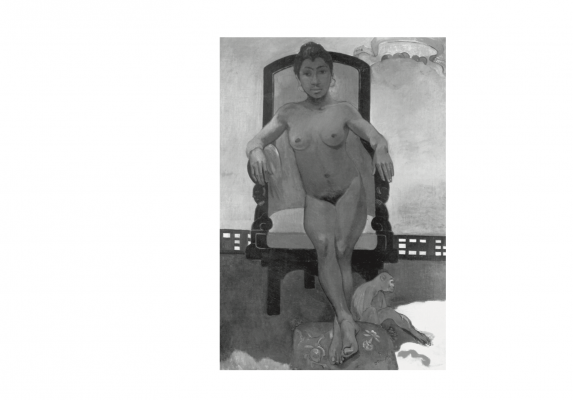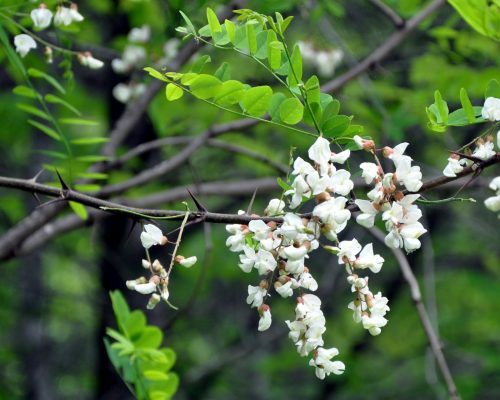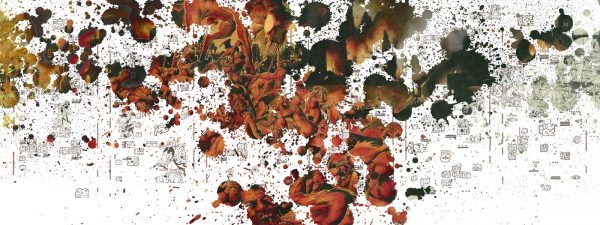The title of Paul Gauguin’s 1893-94 portrait Annah La Javanaise. Aita tamari vahine Judith te parari has two parts, describing its subject in two different languages: literally, ‘Annah the Javanese [in French]. The childwoman (sometimes child-girl) Judith has not been breached [in Tahitian]’. Relatively little is known of the real young person or people who inspired the painting. The instances in which people – whether art historians, the Nobel laureate Mario Vargas Llosa, or writers of art institution copy – have written of Annah contradict each other often, offering up vague and conflicting details of a supposedly insignificant life. Annah’s ethnicity shifts, her origin ranges from ‘streets’ to ‘brothels’; I have seen the exact same picture of a girl labelled ‘Annah La Javanaise’ also labelled as ‘Teha’amana’, a Polynesian teenager who’d been married to Gauguin. There is so much variation in accounts of her life that it’s plausible multiple brown children could have been mistaken for one. For that matter, it’s possible that Annah was trans or of a non-Western gender, though presenting as a girl (and thus possibly desirous of ‘they’ as their pronoun in English). These children exist in the archives as an afterthought, an appendage to a coterie of white, European, male painters in late-nineteenth century France, primarily Paul Gauguin.
I first learned of Annah La Javanaise in 2011. Today it is held in a private collection, inaccessible to the general public except when loaned out to museum exhibitions. I discovered its existence online, and thus experienced it, as most people now do, as a series of pixels on a screen, a digital ghost of an artwork whose original form exists exclusively for its wealthy owners. My first thought upon seeing the picture was that it showed a Javanese girl like myself; a body presenting and labelled as a Javanese woman – though in photographs in the Gauguin archives, a similar-looking girl certainly presents as a child – documented abroad in the nineteenth century, captured in both painted and photographic form. This is rare to see. At that time, I had begun to think increasingly about women’s pain, being in acute and untreated pain myself for what would later be diagnosed as nerve damage. It was this experience that drew me to Annah. The figure – figures – of Annah crystallised ideas that had been on my mind: the link between chronic pain and historical abuse; the way women are less likely to be believed when they experience pain, by the 95 medical establishment and/or friends and family; the compounding of women’s pain due to that disbelief, and the compounding of this disbelief due to gender and race.
Since my discovery of the painting eight years ago, I have held onto Annah dearly as a composite of figures to whom I could relate. Their probable horrors and experiences are different from mine, but here was a labelled-Javanese girl who could well have been in pain, but for whom the possibility of pain does not occur to an ablenormative world. In subsequent years, I have projected scenarios of their escape and self-fulfilment onto my fiction, poetry and visual art, knowing that in reality, a child in their circumstances at that time was very likely to have suffered throughout their life. After all, presenting as young, brown girls in 1890s France, they would have lived lives of isolation, and their guardian Gauguin was a known domestic abuser who would certainly today be classified as a sexual predator. Gauguin delighted in humiliating all women, but targeted women descended from European colonies precisely because they were less protected. In Noa Noa, the journal of his time in Tahiti, Gauguin reminisced, ‘I saw plenty of calm-eyed young women, I wanted them to be willing to be taken without a word: taken brutally. In a way longing to rape.’
Gauguin lived in what was then French Polynesia twice, first from 1891 to 1893 – when he was in charge of an official mission from the French Ministry of Education and Culture – and again from 1895 until his death in 1903. During his first trip to Tahiti, he reportedly took three brides, aged between thirteen and fourteen, and was rumoured to have given them and others syphilis. Yet the artistic result of Gauguin’s Polynesian trips – his famed portraits of brown girls – are not seen as artefacts of abuse but as remarkable contributions to Western art history. In 1896, Gauguin was commissioned to paint a portrait of Vaite Goupil, the nine-year-old daughter of his Tahiti-based French patron Auguste Goupil. The disturbingly adult nature of the portrait may have been what caused Goupil to distance himself from Gauguin, yet there was no known outcry from patrons about Gauguin’s use of brown girls as sexual objects. In Paris and Brittany, between trips to Tahiti, he was seen in the company of Annah – it’s been assumed she was sexually involved with him, though even the fact that she ever posed nude for him is an assumption, and cannot be proven.
Over time, my understanding of who the children labelled as Annah might be has expanded, as I’ve investigated the role of ableism as combined with white supremacy in arts institutions. I’ve grown increasingly aware of the ways in which archival texts and images concerning the figure of Annah impose a set of beliefs and agendas on her, ones that support a very specific power dynamic between subject and artist – in which the former is assumed to be an unharmed muse, no matter what the truth may have been – and which have shaped extant narratives surrounding the real child or children who lived and inspired the painting. A 1950 LIFE Magazine issue described Annah, without evidence, as ‘Gauguin’s Faithless Javanese’; they are portrayed as a willing sexual partner of Gauguin’s in film biopics of the artist, such as 1986’s award-winning (and thoroughly vile in its depiction of the endangerment of children) The Wolf at the Door. Their image is used today in art history classes as an example of Gauguin’s Primitivist oeuvre. Overwhelmingly, Annah has been depicted as supplementary, proof of Gauguin’s closeness to the natives, a tantalising femme fatale, part of the myth of the genius artist, explorer and tamer of foreign wildnesses.
I’m convinced, however, that it’s important to consider the notion, unexplored until now, that Annah La Javanaise is a portrait of a young girl in chronic pain. Why Annah in particular? Why pain? There is a perception that it is counterintuitive to describe people in paintings as potentially pained. But this is only because ocularcentric interpretations permeate the field of visual cultures. A depicted body is assumed to be unpained, until a certain set of cues that abled people understand as ‘cues for pain’ somehow prove that they are pained. Yet as those of us who live with chronic pain know, in photos and in the flesh there is often no way that another person can know we are in pain, nor to what degree. This has formed continual traumas in my own life, which I know that I am far from alone in experiencing.
Disabled* people are the largest minority in the world, and most of us live in or come from places that have borne the brunt of white supremacist political economies, in both the ‘first world’ and ‘third world’, whether lead-poisoned Flint, Michigan or environmentally threatened Kendeng, Indonesia, where opportunities for holistic healthcare have been starved by neoliberal economics and colonial legacies. The medical model of disability, which claims that all ‘differences’ must be ‘healed’ (in other words, stamped out), was so entrenched in Indonesian psyches by Dutch missionary hospital systems that I was only recently reminded of the fact that some Javanese deities are or have been disabled. These assumptions – abled until proven disabled – are deep-rooted, and intrinsically related to colonialist human classification systems. When we look at any image of any human, the default interpretation is that not only are they not in pain, but that the mere possibility of their painedness is preposterous. We have no understanding of bodies that exhibit no outer sign of pain according to abled norms, and yet are in pain. This makes Annah’s pain a certain possibility.
Is this so far-fetched? That a child in the presence of an abusive older man, who seemed to revel in the intimation that they had a sexual relationship, would hurt? This does not mean she was only ever a victim. One story of Annah claims they robbed Gauguin of everything except his art. It’s possible that Annah may have escaped. And even if they didn’t, none of us are just victims of anything. We carry all of our lives in our bodies. These are stratified layers of emotion, complex memories kept in the sternum and soaked in the marrow. Annah would have had this kind of body too, a body that remembers, no matter how we choose to remember them.
I say that Annah could have been a pained body, a functioning pained body. Of course, the varieties of pain are infinite, from the aftermath of a stubbed toe, to fibromyalgia, to varying kinds of headaches. There are spectrums of pain’s longevity, intensity, nature, origin, and crucially, spectrums of its meaning. Only Annah knows what was experienced by their body/ies. It is of urgent necessity to show the continuous, constant links between ableism, racism and sexism within colonial mechanisms. Bringing these to the fore illuminates how much we elide and deny histories of pain in human bodies, particularly vulnerable human bodies, such as those of Annah. Portrayed as vivacious and lively, their wellbeing was profoundly at risk. So here we go. Let’s consider and imagine Annah differently, many different Annahs, Annah as infinite possibilities. The truth is the same distance from our grasp as the 1890s; truth kept with, and belonging to, only them and all the many possible thems.
* I take the word ‘disabled’ to mean a complex combination of socially imposed disabilities (the opposite of ‘enabled’) and other person-specific factors. It is my opinion that a person has the right to self-identify how they wish, as long as it does not hurt others; in line with my transnational community of disability justice activists, I prefer ‘disabled person’ to ‘person with a disability’, the latter term often contributing to further stigma of ‘otherness’ or ‘difference’ – and eugenicist urges to eradicate it.




